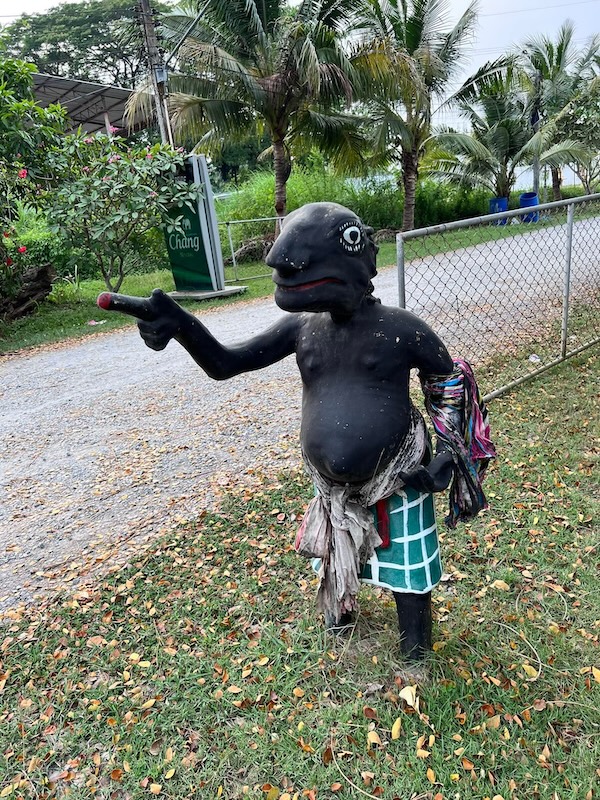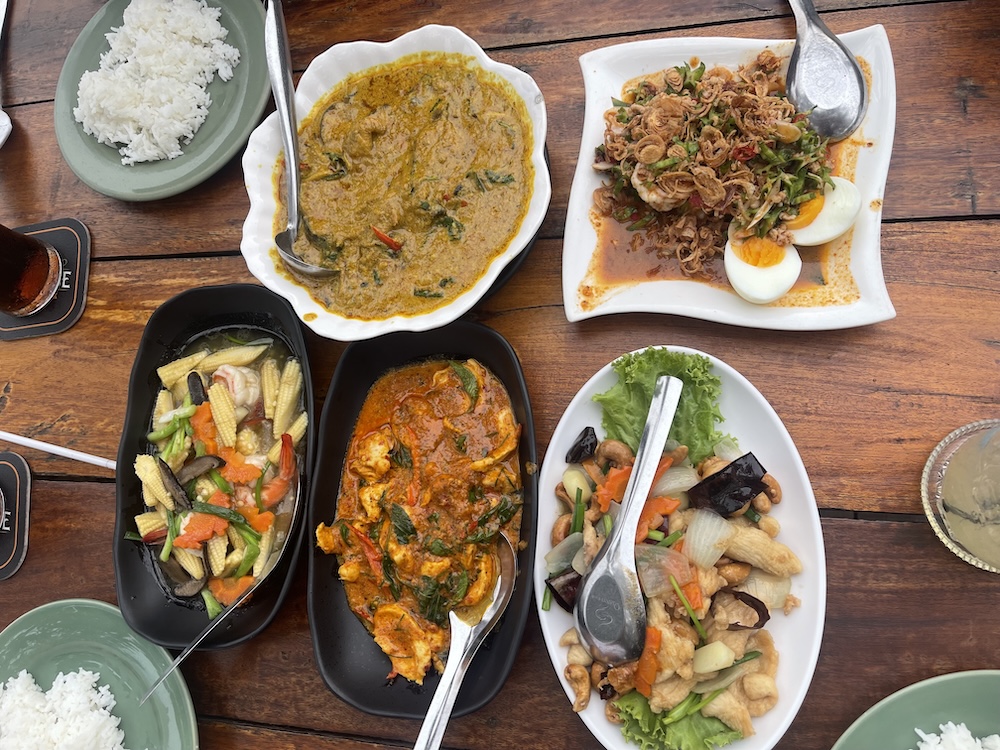Have you ever been in Phuket and spotted a sign with a chubby, dark-skinned man on it—usually with a big smile and a round belly?
If you’re from Europe, you might pause for a moment and wonder, “What’s that about?” At first glance, it might seem unusual, maybe even a little surprising. But there’s actually a fascinating cultural story behind it that has nothing to do with stereotypes or discrimination.

Who is the man with the big belly?
The black man with the big belly that you see on signs or as a symbol in Phuket and other parts of southern Thailand is called I-Teng. His roots go back a long way and are deeply rooted in the traditional art form of Nang Talung, the Thai shadow play. I-Teng is one of the best-known figures in this shadow play, which has been practised in southern Thailand for centuries.
What’s the cultural magic behind Thailand’s Nang Talung shadow theatre?
Nang Talung is the traditional Thai shadow play from the south of the country. Figures carved from leather are illuminated by a beam of light behind a screen so that their shadows are projected onto the wall. A storyteller leads the action, often accompanied by music and singing.
It is a kind of living cinema in which the characters are brought to life with their movements and dialogue – all in the dim light of the shadows. This art form is particularly popular in southern Thailand and has been practised for centuries.

During my trip through southern Thailand in November 2021, I was lucky enough to visit the Khun Suchard Museum in Nakhon Si Thammarat. It was a fascinating experience to learn more about Thai shadow puppetry and take a look behind the scenes. What made the experience even more special was the opportunity to operate a shadow puppet myself.

One of the most popular characters in this traditional shadow play is I-Teng. He’s the classic prankster – a cheeky, clever guy who’s always up to something and never fails to make people laugh. With his quick wit and playful tricks, he stirs things up in the stories, often finding smart and funny ways to turn situations around. He’s not just there for laughs though – I-Teng also has a way of poking fun at society, holding up a mirror in the most entertaining way.
But other characters also contribute significantly to the fascination of this shadow play. Ai Khai, a toothless, mischievous older man with a high-pitched voice, is also a central figure. He’s cheeky, hilarious, and knows exactly how to play with words. A true master of clever comebacks and double meanings, he always keeps the audience on their toes – and laughing.
I-Tong is also an important clown and is often portrayed as Ai Khai’s sidekick. He is lazy, somewhat naïve and sometimes displays a certain innocence, but behind his naïve façade lies a good deal of peasant cunning.
The guy I’m writing about today – I-Teng – is not a symbol of discrimination, but a cultural hero who entertains people through shadow puppetry while humorously addressing deeper social issues. He is a reflection of his time and culture and embodies a heritage that is still present in many aspects of southern Thai society today.
I-Teng today
Over time, the figure of I-Teng has also developed into a kind of pop-cultural symbol of southern Thailand. This is why he is often seen today as a decoration in front of southern Thai restaurants, street stalls or souvenir shops.
Why does the figure of I-Teng stand in front of some restaurants?
Recognisability and regional identity: the figure is strongly associated with the culture. A restaurant that has an I-Teng figure outside the door immediately signals that it serves authentic, spicy, hearty and hot southern Thai food!

Humour and hospitality: The character conveys openness and humour, exactly what one associates with the atmosphere of a good meal. Many southern Thais are proud of their dry sense of humour, and the character I-Teng reflects this perfectly.
Protection and lucky charm: In some cases, the figure of I-Teng is also regarded as a lucky charm that is supposed to drive away evil spirits and ensure good business. Similar to ghost houses.
Marketing with tradition: the striking figure is a real eye-catcher. Locals and even some tourists immediately recognise that this is a culturally rooted restaurant, which promises authenticity and quality.
Conclusion
The little black man with the round belly is therefore much more than just decoration. He stands for local identity, humour, tradition and hospitality. In a country like Thailand, where food and culture are so closely linked, it’s a nice way to visualise both.

In Europe, terms like ‘black’ and ‘man’ have been removed from everyday language because they’re now considered politically incorrect and can lead to misunderstandings.
In Thailand, however, the figure of the ‘little black man with the big belly’ is a cultural symbol that has no negative connotations. It is a humorous and positive part of southern Thai tradition.

Therefore, I would like to assure you that there is nothing to worry about here in Thailand. On the contrary, I can highly recommend this restaurant as it is a wonderful place to experience authentic Thai culture!
Southern Thailand eats differently – strong, spicy, honest
Here in southern Thailand, taste buds work a little differently – things can get pretty spicy! The dishes are boldly seasoned, with lots of chili and intense curry pastes. Sweet? Not so much. Instead, the people in the south love the fiery kick and firmly believe that spicy food is not only delicious but also healthy. No wonder there are so many coconut groves here – creamy, rich curries are almost always on the menu, served with rice and fresh vegetables.
And if you like it really intense, try one of the typical dry curries, which are called Khua Kling here – spicy, hot and definitely not for the faint-hearted!
Khua Kling – the dry curry with a kick
If you think all Thai curries are creamy and mild, you clearly haven’t tried Khua Kling. This classic southern Thai dish is a whole different level: dry, insanely spicy, and totally fiery. Instead of being soaked in coconut milk, the meat – usually pork, beef, or chicken – is ‘dry-fried’ in a pan with a punchy curry paste, letting all those bold flavors really sink in.
What makes Khua Kling special? The combination of intense flavour, fiery chilli and the typical southern spice. There is also often a little lemongrass, kaffir lime leaves and sometimes green peppercorns – all ingredients that really get the palate going.

Perhaps a challenge for beginners, but an absolute must for fans of southern cuisine. If you love it once, you’ll want it again and again!
A separate article will be published here shortly, dedicated entirely to the typical dishes of southern Thailand. So it’s worth coming back again!
